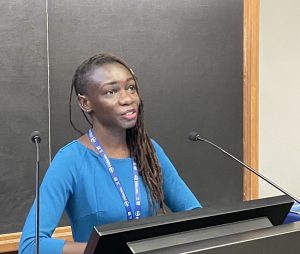We talk to Cynthia Omondi who attended the OnSSET track at the EMP-G in Trieste recently, as a very active participant in the debates there. She shares her views on the energy situation in her native Kenya as well as some of her interests outside her research.

Tell us about yourself please.
I’m Cynthia Omondi and I’m a PhD student at Kenyatta University in Kenya. I came to the EMP-G because I am trying to find tools that I can use for my research. I’m focusing on designing a smart grid system for my country and I saw that the programme had different tools. I was particularly interested in the ONSSET tool because it has to do with electrification.
When you say you want to design a smart grid system, is that because you think that the current options are not appropriate?
We do not have a smart grid system in Kenya. Part of the problems we have are to do with the reliability of the system and so, with a smart network, it would be easier to control the different components like mini grids and to anticipate demand at different times during the day and during the year.
What has been happening over the past year is that we’ve been experiencing nationwide blackouts which are becoming more common. I think a smart grid would go a long way to helping reduce those issues.
How do you hope to achieve that? Is it by convincing the government to build one?
The plan, through my PhD research, is to explore electrification scenarios based on current policies and initiatives, then optimize the performance of the systems through smart technologies. Kenya is currently at 90% renewable electricity, but it has sectors such as transport that have been harder to transition. A smart grid can be optimised to include technologies such as EV charging that would then support the transition to clean energy for the transport sector. The research will provide a key look into existing policy and recommend optimal ways to manage the grid for better performance, and interaction with technologies such as EV charging
Is the current system very old, is that one of the problems?
Yes, the system is very, very old. Most of what we have is still the old system. In some areas, you even see that the poles are just rotting.
I see. What is the main source of energy for your country?
For our grid, we mostly rely on renewable electricity – geothermal, hydropower, wind.
How have you found the experience of being here?
I did not have such a good grasp of modelling, just a basic understanding. But within a short period of time, I was able to get a really clear understanding, and I feel more confident that I can use these tools. Obviously, ONSSET that I came to train on, but because I now have a good understanding of how modelling works generally, I feel more confident to try the other tools. If I want to, I will be able to work on my own because the concepts are the same.
What did you get from the people who shared the course with you?
It was interesting to learn about other countries as well. For our track, we had Zambia, Zimbabwe, Nigeria, and Tanzania. It helps you to get a bigger perspective, so regional rather than just Kenya, because sub-Saharan Africa has different issues. It also helps you to think bigger in terms of how we can collaborate, not just at the Kenyan level, but with all these other countries. We got into a lot of discussions about our countries, giving each other our perspectives.
Are you pleased about the launch of the Energy Modelling Community, because that will mean you can talk to those people. Do you think you’ll be an active part of that?
Yes, I would love to be active because I can say I’ve gained a lot. A lot more than I thought.
I had already started to look into these models and that’s what gave me a bit of understanding of modelling before coming. Now, after the training, I feel better about my abilities, and I can confidently say that I know how to model.

What will you do when you get back? How will you use this learning?
The tools are a good way to assess some of the policies we have. We can now take these tools and apply them to different policies that are to be implemented in Kenya. And this analysis can go a long way to informing our next plans in terms of policy development.
Where do you ultimately want to get to professionally?
Well, I love what I do in terms of research. So that is something that I want to stay on to get better at. What I like most about research is where we get to have an impact with what we do. That’s the best part about it. Sometimes in our country, academia is not taken so seriously when you’re making policy recommendations. So hopefully we can get to a point where that changes and we have more informed decision making.
Outside of your research, what are you involved in?
I am running an NGO that I founded in April this year. I started the NGO (Blessed Citron), as a way to help my country address some of its challenges. Through the NGO, we plan to tackle different forms of inequality. For example, we are developing an AI powered application for the education sector that we will offer for free, I believe this will go a long way to assisting those that lack access to quality education. We are also partnering with some musicians to set up a music program to act as a constructive outlet for at-risk youth and children.
That’s fantastic. Thank you so much.
